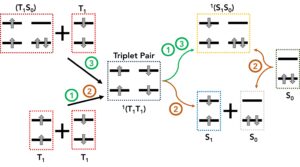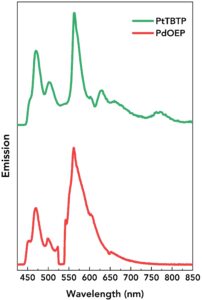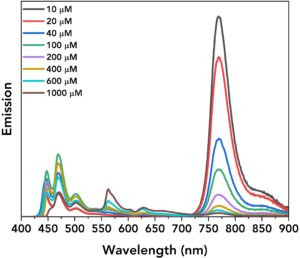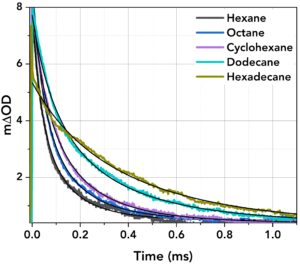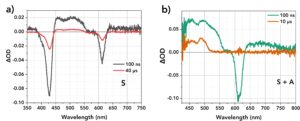Identifying Triplet-Triplet Annihilation Upconversion Loss Mechanisms Using Transient Absorption and Photoluminescence Spectroscopy
Key points
- Triplet-triplet annihilation upconversion (TTA-UC) is an optical method to convert low to high-energy photons even at low light-level conditions.
- Devices based on TTA-UC can be utilised for harvesting solar energy. Increasing the upconversion efficiency decreases energy losses.
- For TTA-UC to occur, two annihilator molecules must form a triplet pair. The environment of the triplet pair strongly affects the UC efficiency.
- Professor Karl Börjesson’s group studied the effect of the environment of the TTA-UC states using an Edinburgh Instruments FLS1000 Photoluminescence Spectrometer and an LP980 Transient Absorption Spectrometer.
- Their results were published in the Journal of the American Chemical Society and provided valuable insights for developing efficient and reliable photon UC devices.
Introduction
The extensive deployment of fossil fuels has led to paramount environmental issues that require immediate and practical solutions to create a greener environment. Solar energy harvesting has been the focus of research into renewable energy. It is crucial to develop more efficient systems for solar energy conversion, such as solar cells and photocatalysts. Triplet-triplet annihilation photon upconversion (TTA-UC) is a method to convert low to high-energy photons. This method can be beneficial in cases where a visible light reaction rate is low due to shallow light absorption, and the more considerable penetrating ability of low energetic IR photons can improve photocatalyst excitation.
Two molecular components are required for the TTA-UC to occur: a sensitiser and an annihilator. The sensitiser absorbs low-energy photons, and the excited-state energy is transferred to an annihilator via triplet energy transfer. In its triplet excited state, a second annihilator is required to form a triplet pair with the first annihilator, resulting in TTA. The same triplet pair also allows the formation of an excimer, i.e., one molecule in its ground state and one molecule in its excited state. Excimers emit low-energy photons and can reduce the overall energy conversion efficiency of a TTA-UC system. Knowing how an excimer is formed can enhance system efficiencies since their formation is an unwanted process in TTA-UC.
Figure 1 The suggested mechanisms for excimer formation in TTA-UC.
A team of scientists, led by Professor Karl Börjesson, proposed three excimer-formation mechanisms (Figure 1) that were then identified experimentally. The first mechanism involves the formation of an excimer directly from the triplet pair, mechanism 1. The second includes the formation of monomers from the triplet pair. Then, the formation of an excimer via molecular diffusion, i.e., an annihilator in its excited singlet state, collides with a ground-state annihilator, forming an excimer, mechanism 2. Mechanism 3 regards the formation of a stable dimer on the triplet surface (T1S0) before annihilation occurs.
A molecule’s TTA-UC efficiency strongly depends on multiple factors, including the properties of the annihilators, the excitation source, sensitisers, solvents, and their relative concentrations. Such studies were performed by the authors of the paper, who examined the effect of the environment on the excited states’ conversion in sensitised TTA-UC. Their results were published in the Journal of the American Chemical Society in 2019.1
Experimental Setup
Steady-state photoluminescence (PL) and Transient Absorption (TA) measurements were performed using the Edinburgh Instruments’ FLS1000 Photoluminescence Spectrometer and LP980 Transient Absorption Spectrometer (Figure 2).
Figure 2 The Edinburgh Instruments FLS1000 Photoluminescence Spectrometer and LP980 Transient Absorption Spectrometer.
The FLS1000 was equipped with a microsecond flash lamp, multi-channel scaling (MCS) electronics for lifetime measurements, and a visible PMT as a detector. The LP980 was equipped with a PMT for kinetics acquisition and an ICCD camera for TA spectral measurements. An optical parametric oscillator was used as the main excitation source for the LP980 to allow for wavelength tuning. Laser pulses at 617 nm were used for all the TA data.
Photoluminescence Spectra with FLS1000
In this work, perylene was used as the annihilator, and two metal porphyrin complexes were chosen as sensitisers: palladium octaethylporphyrin (PdOEP) and platinum tetrabenzotetraphenylporphyrin (PtTBTP).
Figure 3 TTA-upconversion spectra of PdOEP (red) and PtTBTP (green) in 1 mM perylene in tetrahydrofuran (THF).
Using the FLS1000 PL Spectrometer, the TTA-upconversion spectra of both molecules, PdOEP in red in Figure 3 (excited at 532 nm) and PtTBTP in green (excited at 617 nm), were acquired. The emission spectra allowed for the calculation of the anti-Stokes shift for both sensitisers via the energy splitting of sensitisers and annihilator: 0.54 eV for PdOEP and 0.79 eV for PtTBTP. It is also suggested that the triplet energy of the molecules is transferred to perylene, which can quench the molecules’ phosphorescence. The large emission band around 565 nm is sensitiser-independent and attributed to excimer-state emission.
Figure 4 TTA-UC emission spectra of 10 µM PtTBTP, excited at 617 nm, at different concentrations of perylene in deoxygenated THF solution.
Figure 4 shows the study of the excimer formation-annihilator concentration dependency by increasing the perylene concentration in a solution of PtTBTP and deoxygenated THF using the FLS1000. As the concentration of perylene increases, the annihilator-annihilator distance becomes shorter, enhancing diffusion processes and an increase in the excimer emission is observed concurrently with a decrease in the monomer’s emission.
These experimental results on the ratio of the monomer/excimer emissions cannot be fully explained by the theoretical models proposed by the authors: a model based on mechanism 1 is sufficient for low concentrations but struggles with the high emission of excimers at high concentrations, and a model based on mechanism 2 fails to explain the rapid increase in excimer emission at high annihilator concentrations. However, mechanism 2 sufficiently explains the excimer emission upon direct excitation of the annihilator.
Transient Absorption Kinetics and Spectra with LP980
The authors examined the effect of the increase in viscosity of the solvent, which affects molecular diffusion and, thus, excimer formation. Additional optical measurements of the mixture of PtTBTP and perylene with different solvents showed that as the solvent’s viscosity increases, so does the efficiency of the TTA-UC.
Figure 5 TA kinetics of PtTBTP and perylene in different solvents. Emission and excitation at 485 nm and 617 nm, respectively.
The latter was supported by time-resolved measurements using the LP980 TA Spectrometer equipped with a PMT. The TA kinetics of the PtTBTP and perylene solution diluted in different alkane solvents were acquired (Figure 5). The fit results enabled the authors to calculate the TTA possibility of triplet perylene, showing that in more viscous solvents, the triplet pair complex is kept in a favourable geometry for a longer time, enhancing the TTA-UC efficiency.
Further investigations to confirm that the emission originates from a triplet pair were conducted using the LP980 and an iCCD camera for TA spectral absorption measurements for a sensitiser solution (PtTBTP, S), Figure 6a, and a sensitiser plus annihilator (PtTBTP plus perylene, S+A), Figure 6b.
Figure 6 TA absorption spectra at 617 nm excitation of a) 10 µM PtTBTP (sensitiser, S) and b) 10 µM PtTBTP and 1 mM of perylene (sensitiser and annihilator, S+A) in THF.
The large absorption bands at 430 nm and 610 nm are attributed to ground-state bleach and are in accordance with the S1 and S2 energies. The excited-state absorption between 460 nm and 512 nm is due to triplet state transitions, and further absorption kinetics measurements confirmed that all the TA traces originate from the same T1 state.
Conclusion
The FLS1000 Photoluminescence Spectrometer and LP980 Transient Absorption Spectrometer were used to identify the excimer mechanism formation for perylene-based TTA-UC. The findings of this work provide valuable insights into the photophysical mechanisms of TTA-UC that can be used to develop efficient photon upconversion devices for potential photovoltaic applications.
Full Publication
The results shown in this Research Highlight were published in the Journal of the American Chemical Society, and more details can be found here: https://pubs.acs.org/doi/10.1021/jacs.9b02302.









